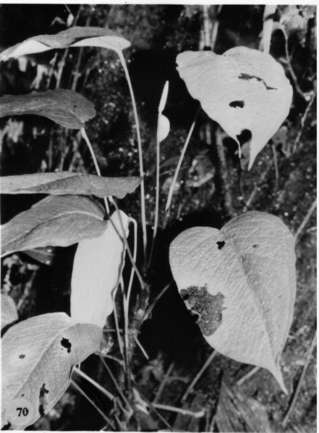Anthurium davidsoniae Standl.,
Publ. Field Mus. Nat. Hist., Bot. Ser. 22: 4. 1940. TYPE: Panama. Chiriquí: Bajo Chorro, Boquete District, 1,800 m, 17 January 1938, M. E. Davidson 134 (F 915728, holotype; MO, US, isotype).
Usually terrestrial, rarely epiphytic; stems elongate, less than 1 cm diam.; internodes short at apex, longer in lower portion of stem; cataphylls moderately thick, to 12 cm long, drying reddish-brown.
LEAVES ± erect; petioles shallowly sulcate with sharp marginal ribs adaxially, 13-27 cm long, 2.5-3.5 mm wide; blades ovate to narrowly ovate, ± charlaccous, usually conspicuously bullale, 15-23 cm long, 9.5-15.5 cm wide, long-acuminate at apex, shallowly and broadly lobed at base; the upper surface pale green, the lower surface slightly paler; the midrib narrowly raised; primary lateral veins 10-12 per side, sunken, straight or weakly arched to collective vein; collective vein arising from the first or second basal vein, 6-8 mm from margin.
INFLORESCENCE erect, shorter than leaves; peduncle 9-19 cm long; spathe lanceolate, pale green, 3-5 cm long, 5-10 mm wide; spadix pale yellow-green, 2-4 cm long, 5-7 mm diam. at base, 2-3 mm diam. at apex; flowers rhombic to 4-lobed, 2.3-2.7 mm long, 2.7-3 mm wide: 3-5 flowers visible in the principal spiral, 4-7 flowers visible in the alternate spiral; tepals matte, lateral tepals 1-1.2 mm wide; pistil emergent, green; stigmas exserted, brushlike; stamens emerging but may retract (not evident on dry specimens).
INFRUCTESCENCE with spadix 3.5-6 cm long; berries greenish-yellow; mesocarp syrupy; seeds obovoid, yellow-green, darker at apex with numerous raphide cells visible on the surface. Fig. 70.
Anthurium davidsoniae is known from Costa Rica and western Panama, from 1,300 to 2,000 m elevation in premontane rain and lower montane rain forest. The species is related to both A. pallens and A. microspadix, although more closely to the latter. All of these species share a similar habil with elongate stems and a similar inflorescence. Anthurium davidsoniae differs from both others by having a much broader, more ovate, more conspicuously bullate leaf blade. All three of the above species occur in similar cloud forest habitats and evaluation of herbarium material alone is unsatisfactory in separation considering the variability of Anthurium. Field observations have convinced me, however, that they are all good species. Anthurium davidsoniae and A. microspadix are both semi-erect I plants and are usually terrestrial but require something to lean on for support. Anthurium aliens is usually a pendent epiphyte. Anthurium davidsoniae is placed in section Xialophyllum an alliance I refer to as the A. microspadix jaBiance. This group, which differs substantially from other members of section Xialophyllum such as A. caucanum Engl., may ultimately have to be considered a separate section. All species in the group share thin, prominently veined, often bullate leaves, elongate slender stems, and commonly green inflorescences and fruits.
 |
Map of Mesoamerican specimens with coordinates
Costa Rica : 1550-1600 m, 10.18N 84.47W, 19 Aug 1984, Michael H. Grayum
& Pam Sleeper 3839 (MO).
Costa Rica Alajuela:, , Smith 1123 (NY).
Costa Rica Alajuela:, , Smith 431 (MO).
Costa Rica Cartago: 1500-1700 m, 09.43N 83.47W, 12 July 1984, Michael
H. Grayum & Pam Sleeper 3478 (MO).
Costa Rica Cartago: 1650 m, 09.42N 83.47W, 11 Aug 1984, Grayum et al.
3758 (MO).
Costa Rica Cartago:, , Standley 39928 (US).
Costa Rica Cartago:, , Burger & Burger 8434 (F, MO, U).
Costa Rica Cartago: 1350 m, 09.47N 83.48W, 29 Sep 1984, Michael Grayum
3929 (MO, US).
Costa Rica Guanacaste:, , Primack et al. 433 (DUKE).
Costa Rica Heredia: 1850-1880 m, 10.12.00N 84.06.30W, 22 April 1986,
Michael H. Grayum 7356 (MO).
Costa Rica Heredia:, , Thomas B. Croat 36023 (MO). Costa Rica Heredia:,
, Skutch 3644 (MICH, MO, NY).
Costa Rica Lim—n: P.N. Cordillera de Talamanca; Cordillera de Talamanca,
1450 m, 09.24.20N 83.13.30W, 3 April 1993, Gerardo Herrera 6175 (CR).
Costa Rica Puntarenas: Monteverde reserve,, , Burger & Baker 9734
(F, MO).
Costa Rica Puntarenas: Monteverde Reserve, 1500-1550 m, 10.18N 84.48W,
17 Nov 1972, Ingram & Ferrell-Ingram 1731 (MO).
Costa Rica Puntarenas: 1500 m,, 4 agosto 1985, William A. Haber &
Eric Bello C. 2228 (MO).
Costa Rica Puntarenas: 1500-1620 m,, 6 Sept. 1984, Willow Z. Pounds
323 (MO).
Costa Rica Puntarenas: Cordillera de Tilarán, 1100 m, 10.16.20N
84.49.30W, 17 June 1993, Zobeida Fuentes 369 (CR, MO).
Costa Rica San José: Cerro Zurqui,, , Almeda 3687 (CAS).
Costa Rica San José:, , Taylor 11303 (NY).
Costa Rica San José: 1100-1200 m, 09.33.30N 84.03.15W, 5 September
1996, Thomas B. Croat 78932 (INB, MO).
Panama Chiriquí: 1800-2200 m, 08.49N 82.23W, 7 Feb 1986, Michael H.
Grayum 6407 (MO).
Panama Chiriquí: 1100-1500 m,, Aug 1984, W.G. D'Arcy & C. Todzia
15955 (MO).
Map of South American Specimens with coordinates
Colombia Valle del Cauca: 03.30.36N 076.37.00W, 17 July 1997, Thomas B. Croat & John F. Gaskin 79951 .



